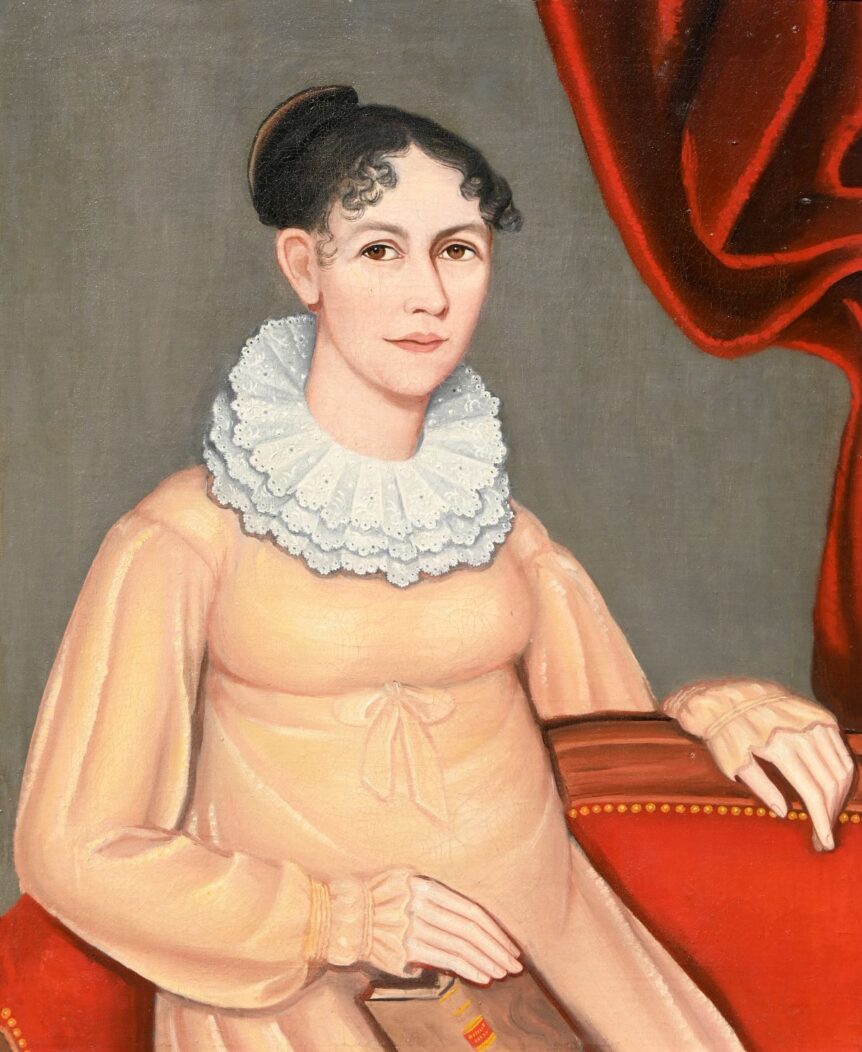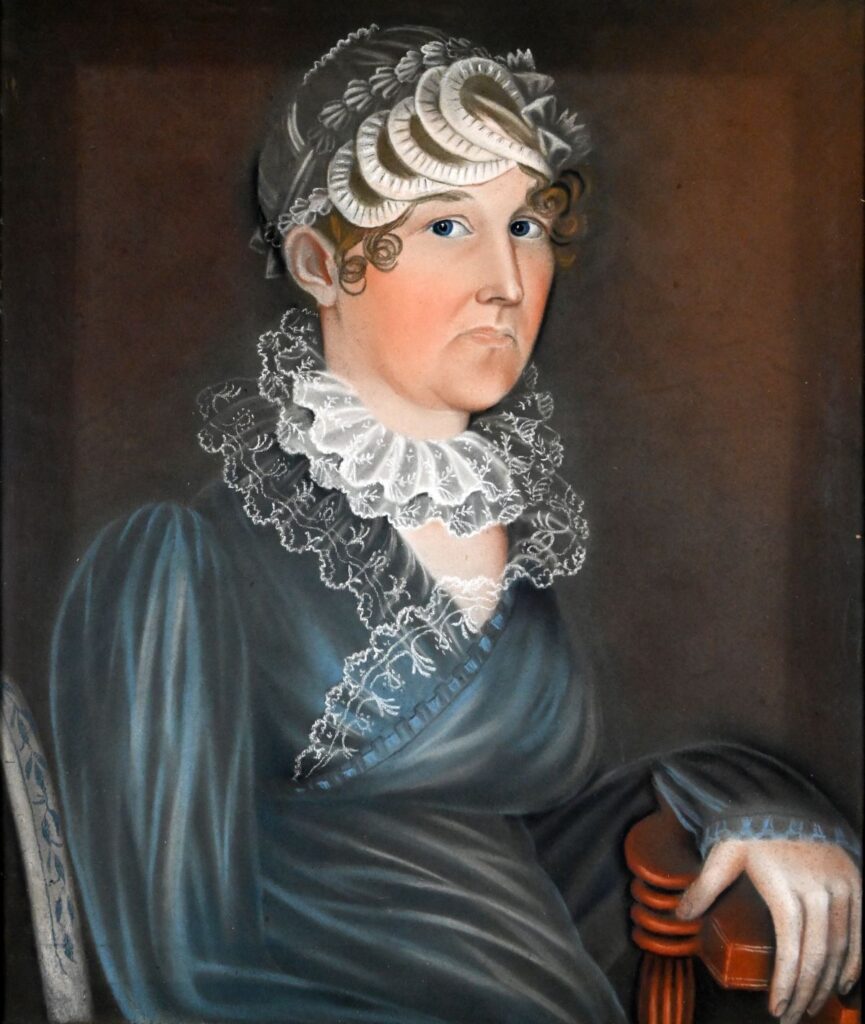
Imagine, just for a moment, that it is the early 1800s. You are a typical resident of the northeastern United States, living in a town with fewer than twenty-five hundred residents, surrounded by miles of farmland. The area’s major roads intersect at the town center, where churches, a hotel, and several stores are located. You and your neighbors are excited because an itinerant portrait painter has arrived in town and advertised that sample portraits are on display. While your Bible and books have a few dark illustrations, the artist is painting vividly colored, life-sized portraits of people just like you. Everyone comes to see these marvels and watch the painter at work. The artist Susanna Paine (1792–1862) described her stay on Cape Ann, Massachusetts, in 1833: “As there were few places of amusement in this out of the way place; my painting-room was a place of general resort; I was liberally patronized.” Even in a larger town like Salem, Massachusetts, her “exhibition-room was constantly thronged with callers; frequently more than one hundred in a day.”1 For the first time, the idea of having a portrait of yourself or family members enters your mind. You even imagine that perhaps you could guide the artist to produce a portrait of a deceased child or parent.
After the Revolutionary War, Americans continued to embrace a transplanted academic English portrait style that emphasized objective realism. Artists went to England for training and then returned to America. However, starting in the late 1790s and continuing through the 1840s, a new generation of artists, born and trained in America, developed an innovative portrait style that reflected the changes and new ideas occurring in American society. Today these paintings are often called “American folk portraits,” a term that does not adequately distinguish them from any other amateur art. The name also implies that they were inferior to academic portraits and painted by artists with limited training. To correct these misconceptions and provide this portrait genre with a defining name, we prefer to call them “Federal American vernacular portraits.”
At the dawn of the nineteenth century, a few intrepid men and women believed they had enough talent to be professional artists. They quickly learned about the difficulties of obtaining art supplies, convincing sitters of a portrait’s value, and collecting payment. To enhance their chance of success, they often advertised a variety of portrait styles and mediums—such as silhouettes, watercolors, pastels, and oils on canvas—with prices ranging from twenty-five cents for two silhouettes to twenty dollars or more for an oil portrait. While European royalty and elites had traditionally been the subjects and patrons of portraiture, an extraordinary new era began in America, in which almost every home was able to afford a portrait done by a professional artist. One artist advertised that, if you paid two dollars a week, after just twelve weeks you would own your own oil portrait.2
This was a time of unprecedented growth in art education. Private academies that taught practical drawing were common in major cities, and art instruction books by American authors were popular.3 There were many ways to learn how to paint: an apprenticeship, lessons from a practicing artist, or just starting with an instruction book. John C. Bell and his son Thomas advertised in Alexandria, Virginia in 1808 that they taught “Water Colors 6 dollars per quarter and for Oil colors, ten dollars.”4 In Portland, Maine, twelve different schools offering painting instruction advertised in the Eastern Argus newspaper between 1820 and 1830. Several artists also specifically described that they learned to paint by commissioning their own portrait. Interest was particularly fostered at the numerous academies for young ladies, where the students’ education often included instruction in painting from paid art teachers.5
To become an artist often required youthful brashness and a desire for self-improvement. For example, Isaac Augustus Wetherby (1819–1904) wrote: “I commenced painting . . . at age 15. . . . A miserable blotch of a Painter came to Norway Village [Maine] . . . & my Father had me go to learn to paint portraits with him, his name was Rice. I had not been with him long before I could paint better portraits.” Wetherby also owned several drawing instruction books and a book about famous artists.6 Augustus Fuller (1812–1873), who was deaf and mute, learned both sign language and painting. In 1833 his father took him to Boston for several weeks of lessons with the artist Chester Harding (1792–1866) at a cost of $64.50. Fuller spent the rest of his life as an artist traveling in New England and New York State.7
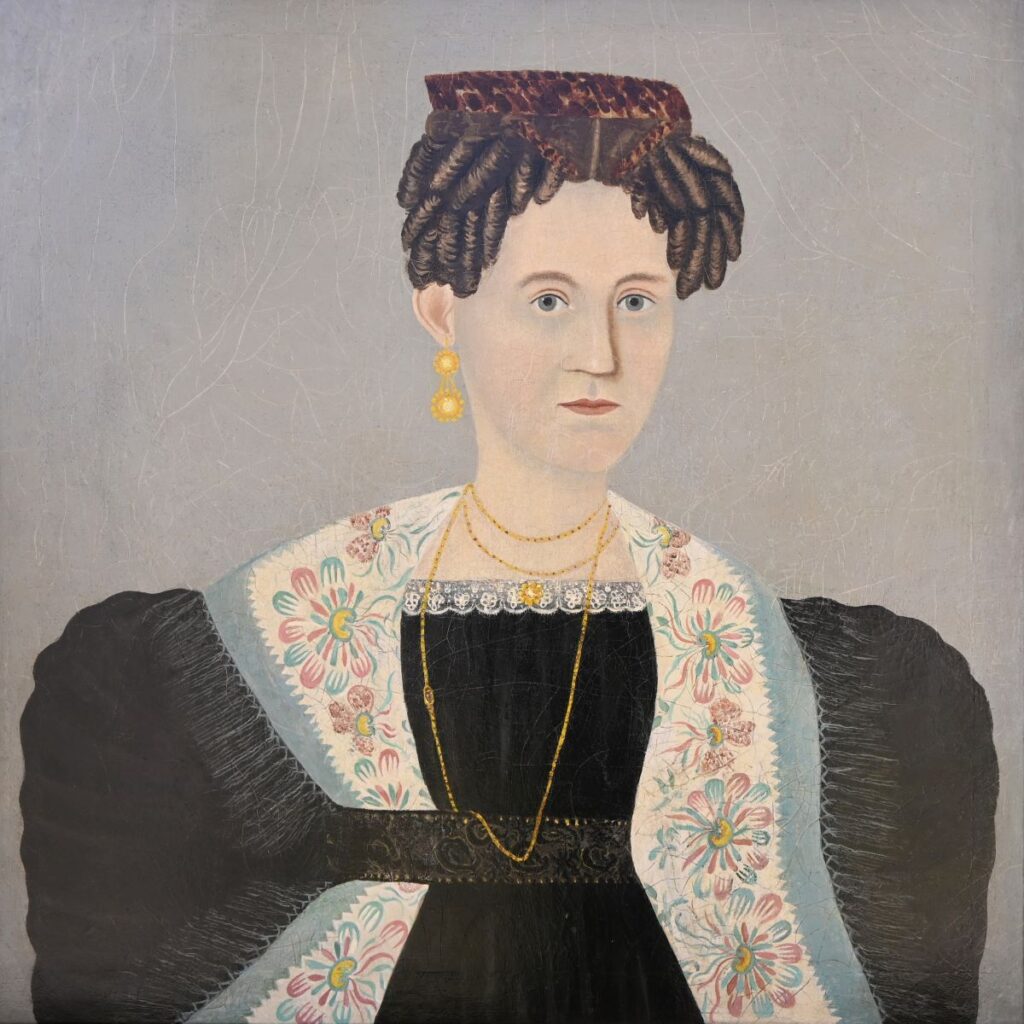
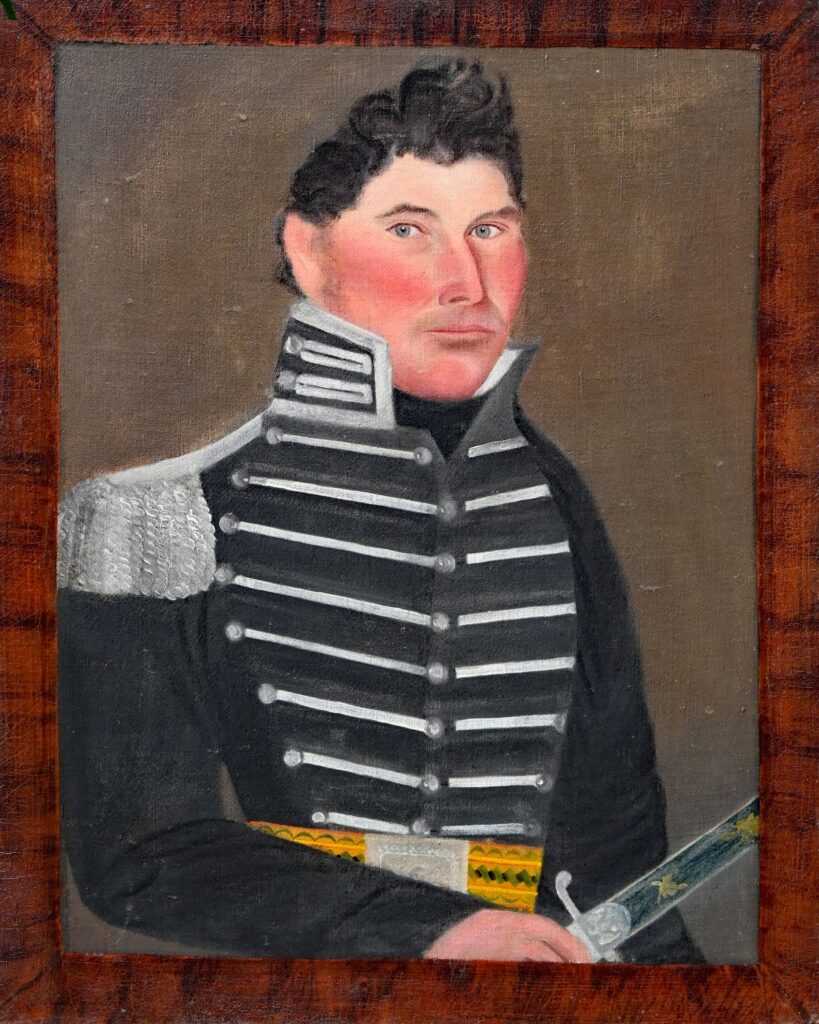
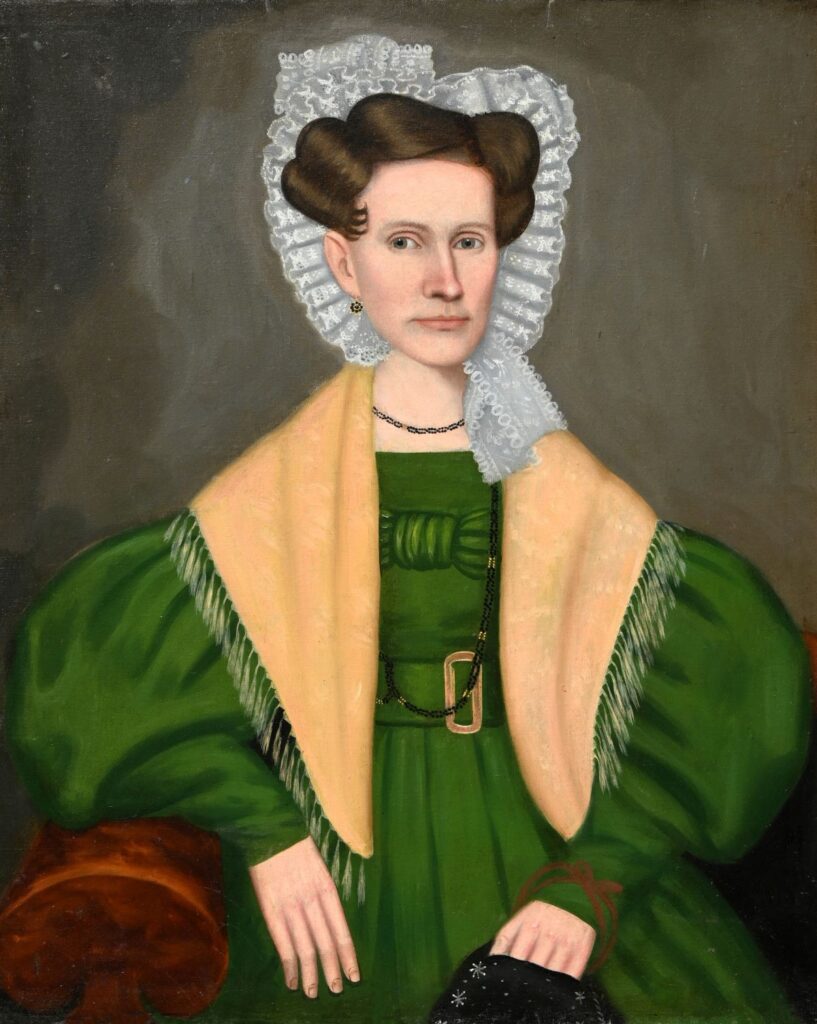
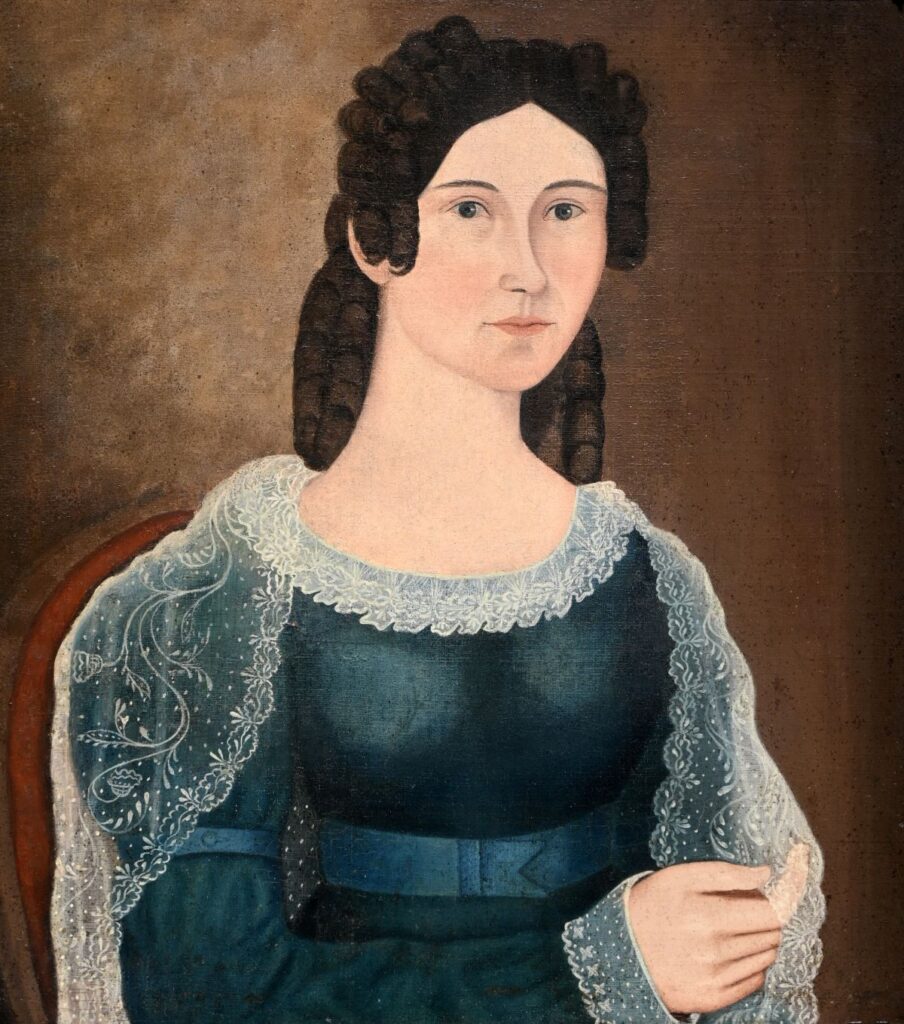
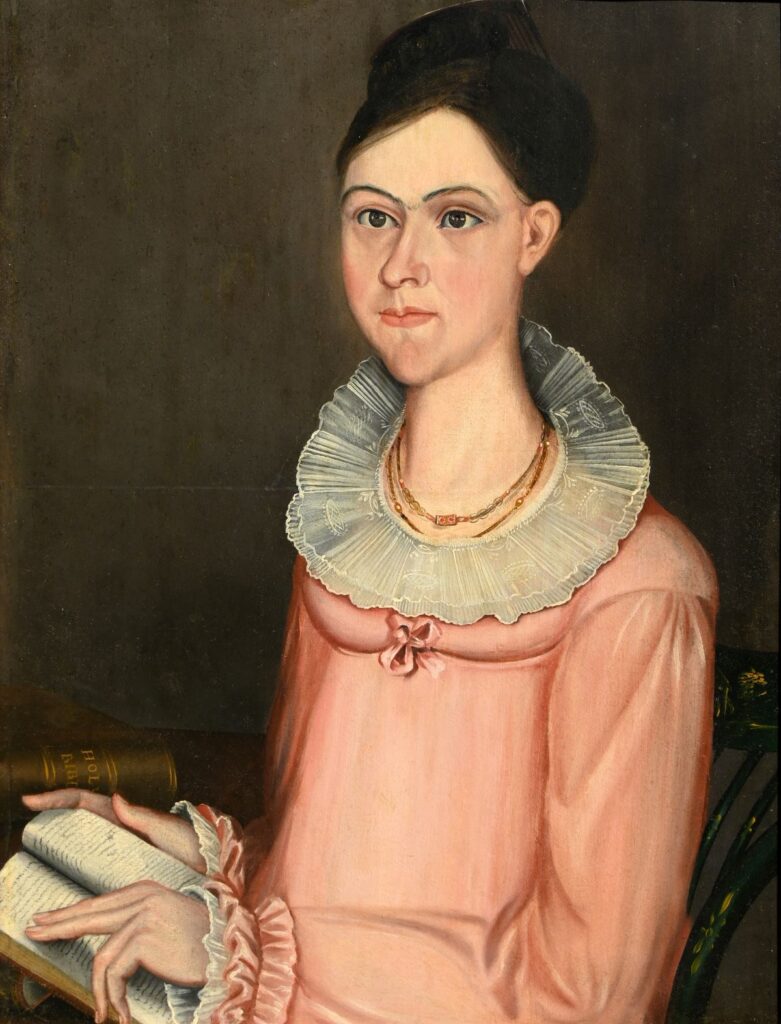
inches (sight). Portraits by this unidentified artist all feature sitters with an elongated body and a facial expression that suggests impatience. The portrait conveys a vivid human presence in an image that seems loud and yet oddly tranquil.
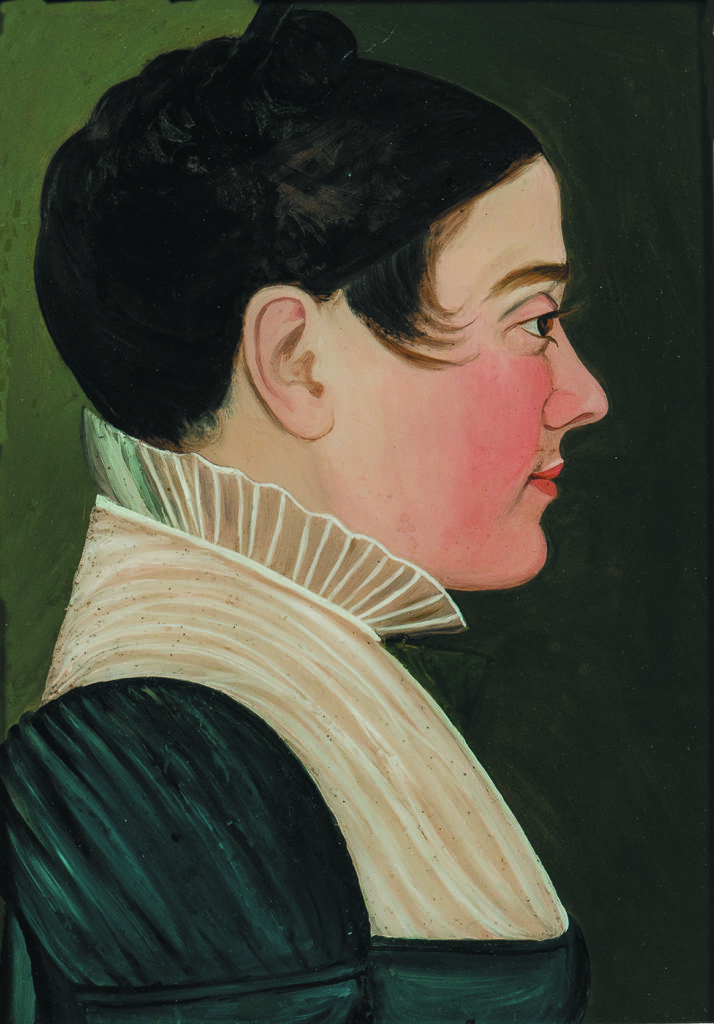
1821), New England, c. 1810. Oil reverse-painted on glass, 14 by 9 1/2 inches (sight). This large bust-length profile focuses on the sitter’s features, so that her character could be read using physiognomy and phrenology. A similar portrait of another Goold daughter descended with this one.
James Guild (1797–1844) wrote of his first attempt to paint a portrait: “it could not be caled [sic] a painting, for it looked more like a strangle [sic] cat than it did like her.” He later paid a painter five dollars for lessons, which included receiving one of the artist’s paintings.8 Susanna Paine described her decision to begin painting at the age of thirty-one, after a divorce and the death of her only child: “I thought, in this extremity, to try my hand at painting portraits, having painted several in crayons, which proved to be a correct likeness, I commenced the labors of an artist.” During 1826 in Portland, Maine, she advertised oil portraits for eight dollars or in crayon for four dollars.
Every artist had to acquire the skills needed to prepare the materials required for painting because only limited amounts of commercially manufactured art supplies, mostly imported from England, were available in America.9 In Boston, importer Samuel Tuck advertised in 1807 that he had thirty-eight pigments, watercolors, crayons, and solvents for sale. However, many artists complained of the expense. Hundreds of books were published in America describing how to prepare and work with artists’ materials. Earlier texts written in England, such as Robert Dossie’s Handmaid to the Arts (1758) and Thomas Bardwell’s Practice of Painting and Perspective Made Easy (1756), were considered particularly reliable and were repeatedly reprinted in this country.
For an oil portrait, each color pigment, which could be a mineral, plant extract, or a manufactured chemical, had to be either purchased or prepared by the artist. The pigment was then made into usable paint by following a labor-intensive recipe that required grinding and mixing with oils and various additives using a stone and muller. While some prepared paints could be stored for a short time in a leather pouch, many needed to be freshly made for each day’s sittings. Stretched canvas had to be primed to form a flat surface, but a constant complaint was that a primed canvas cracked or poorly bound the paints. Difficulties with art materials meant that every artist had to continuously experiment with new recipes and supplies.
Starting in the late 1830s, American-made art supplies became increasingly available as new professional “colormen” opened stores. Between 1841 and 1842, John Goffe Rand, an American painter in London, developed collapsible tin tubes that allowed oil paints to be commercially sold. Even so, many artists continued to make their own paints into the 1850s.
Most artists were itinerant, regularly moving from town to town seeking commissions. Traveling with one’s possessions and cumbersome art materials by wagon or stagecoach was arduous, expensive, and slow at the four-miles-per-hour speed of a horse. Susanna Paine described that, as a single woman, she would never travel at night and that she moved between towns by first sending letters of introduction to a boarding house recommended by a friend. She would still demand to inspect the premises before deciding to stay.
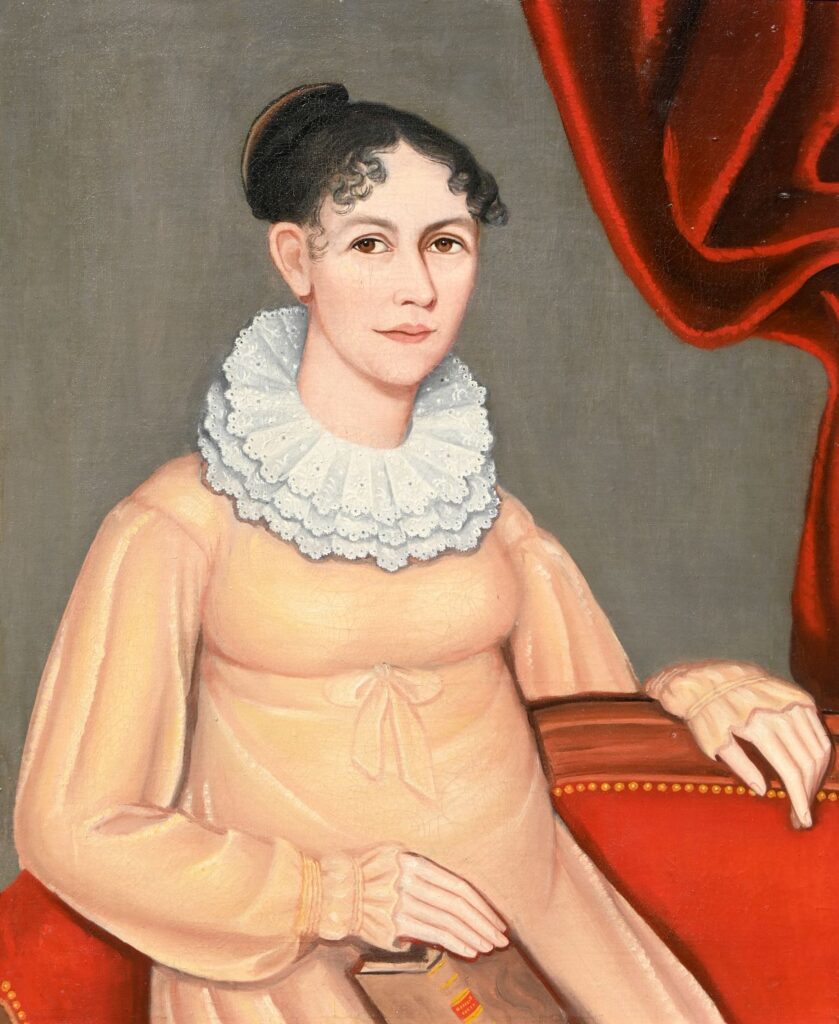
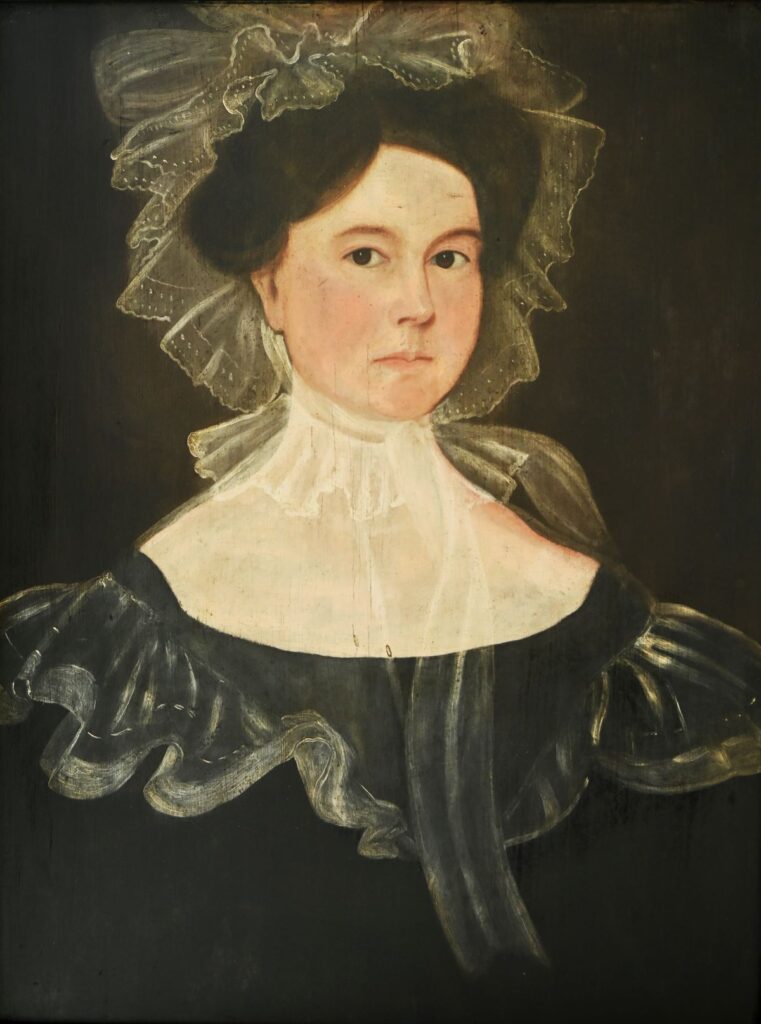
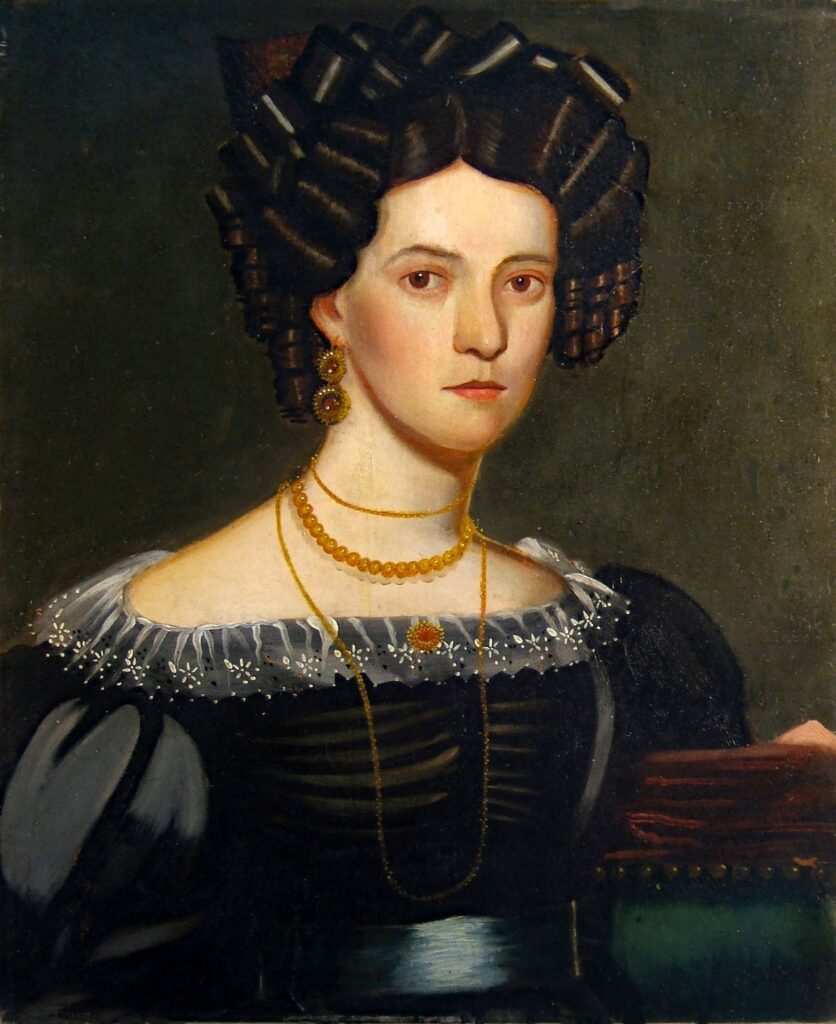
Fig. 10. Woman with Elaborate Hair attributed to the Borden Limner, New England, c. 1830. Oil on canvas, 24 by 19 3/4 inches (sight). A romantic blend of representation and impression, this likeness is centered and stabilized by the well-modeled face. The finely detailed hair, with its radiant color and painted reflections, appears almost three-dimensional.
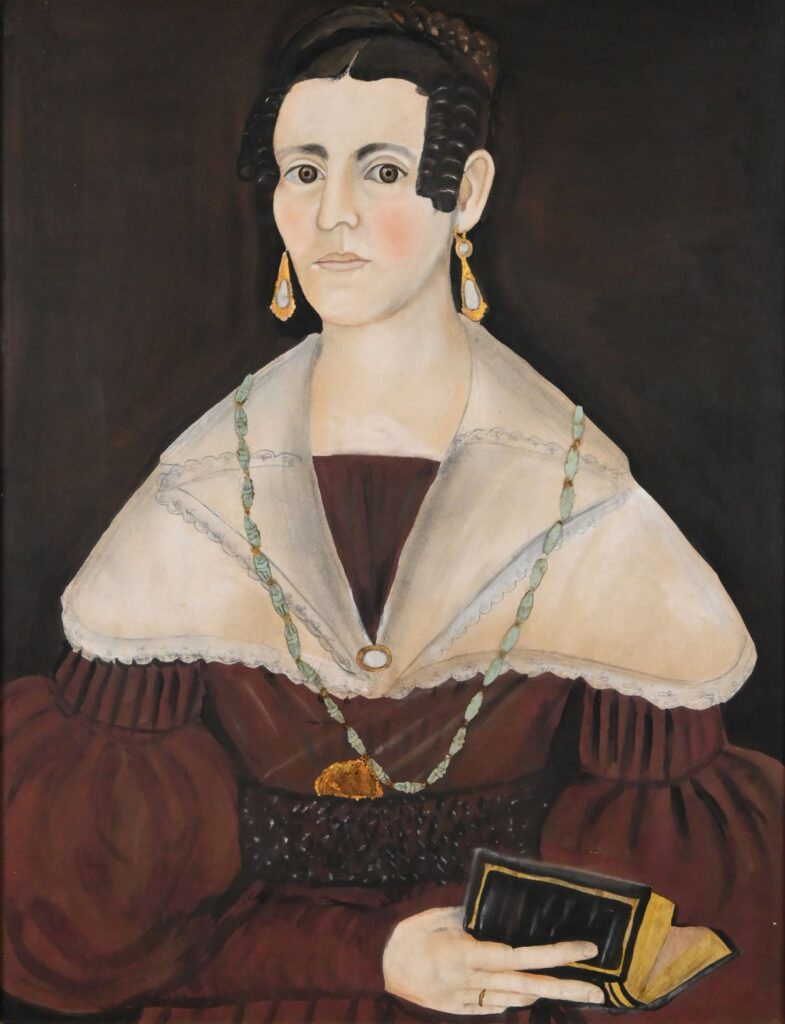
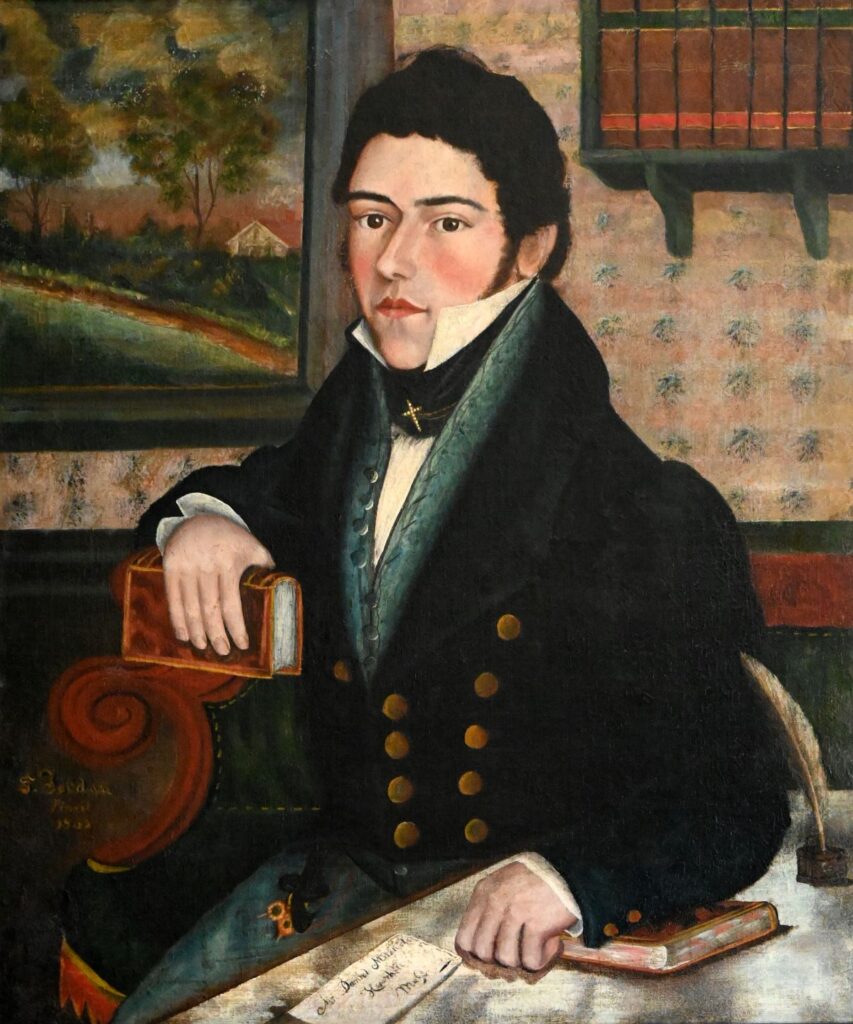
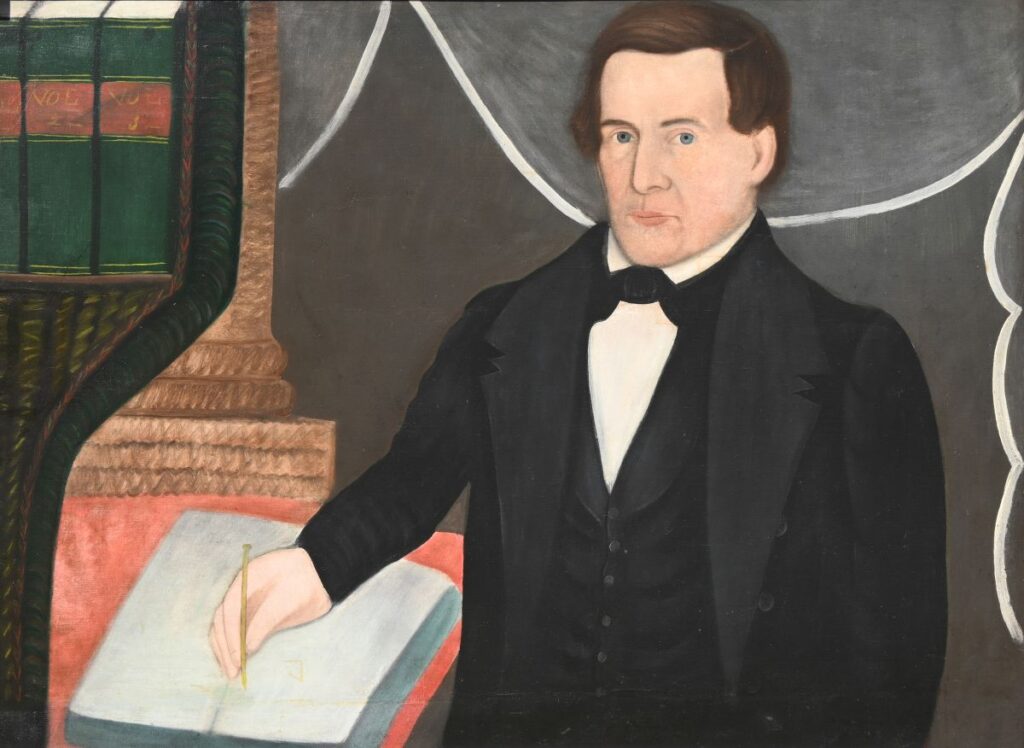
Upon arriving in a new town, the first task was to rent a painting room in a prominent location with plenty of natural light. Sample portraits were displayed to help attract sitters and the studio was open for all to see the artist at work. Advertisements in a local newspaper, or a printed flyer, coaxed townspeople to visit by announcing that the artist would be in residence for only a limited time. Oil portraits for the more prosperous citizens had an average price of twenty dollars, equivalent to the price of two horses at the beginning of the nineteenth century (Figs. 4–6, 8).
Many advertisements did not specify a portrait’s price and payment usually required negotiations. Money at the time was a combination of English currency, foreign and United States coins, and, most prominently, paper banknotes issued by private local banks, which decreased in value the farther one traveled from the originating bank. Many people expected to pay with farm produce or by trading goods. Justus Da Lee (1793–1878), who produced small watercolor portraits, wrote in 1845: “I was in Geneva [New York] about 14 weeks; took 93 ports [portraits] made about $110 in cash- A New Dress Coat $15-Trade at store & Tin shop $15- Candy . . . $6.” From Ithaca, New York, he wrote: “we took miniatures to the Amt. of $80 in all . . . Cash $50, Shoes $5.50- Webster’s large dictionary $4- A N.Y. State Atlas . . . $12 other things $8.50.”10 Isaac Augustus “recorded that payments for his oil portraits were often received as small sums over several years, as well as in the form of groceries, dental work, a coffee mill, and even shares in the “Dorchester and Milton railroad.”
These portraits were immensely popular as they mirrored the major intellectual and aesthetic changes occurring in American society. The philosophy of romanticism and the pseudo-sciences of physiognomy and phrenology deeply influenced Americans’ perception of the world around them and each individual’s conscious thoughts. Romanticism, a literary and artistic movement that began in Europe during the late eighteenth century, encouraged the expression of emotions, spontaneity, and the individual self. A philosophy that embraced the positive powers of imagination and creativity, romanticism offered a new freedom of artistic creation using heightened expression and imagery. The romantic philosophers also encouraged art as a career, seeing artists as heroic figures who raised the quality of society.11
The portrait painter Ira Chaffee Goodell (1800–1877) described the deep influence romantic literature had on him. The son of a poor farmer in rural Belchertown, Massachusetts, he wrote: “when I was 14, 15 and 16, I used to . . . lay a good deal of cobble stone wall. . . . I often had a book of poems spread out upon the wall before me, so that, as I laid up a stone or two I could snatch a line or so of poetry, and in that way I could commit to memory.”12 He fondly remembered reading works by Shelley, Wordsworth, Keats, and Byron, among others. American romantic novels included Washington Irving’s Rip Van Winkle and Legend of Sleepy Hollow and James Fenimore Cooper’s Last of the Mohicans. They, along with numerous other still-beloved books, constituted an “age of romanticism” that has been described as the first literary movement in American history.13 During the same decades, itinerant artists were producing portraits for an eager public using the new romantic style of painterly expression.
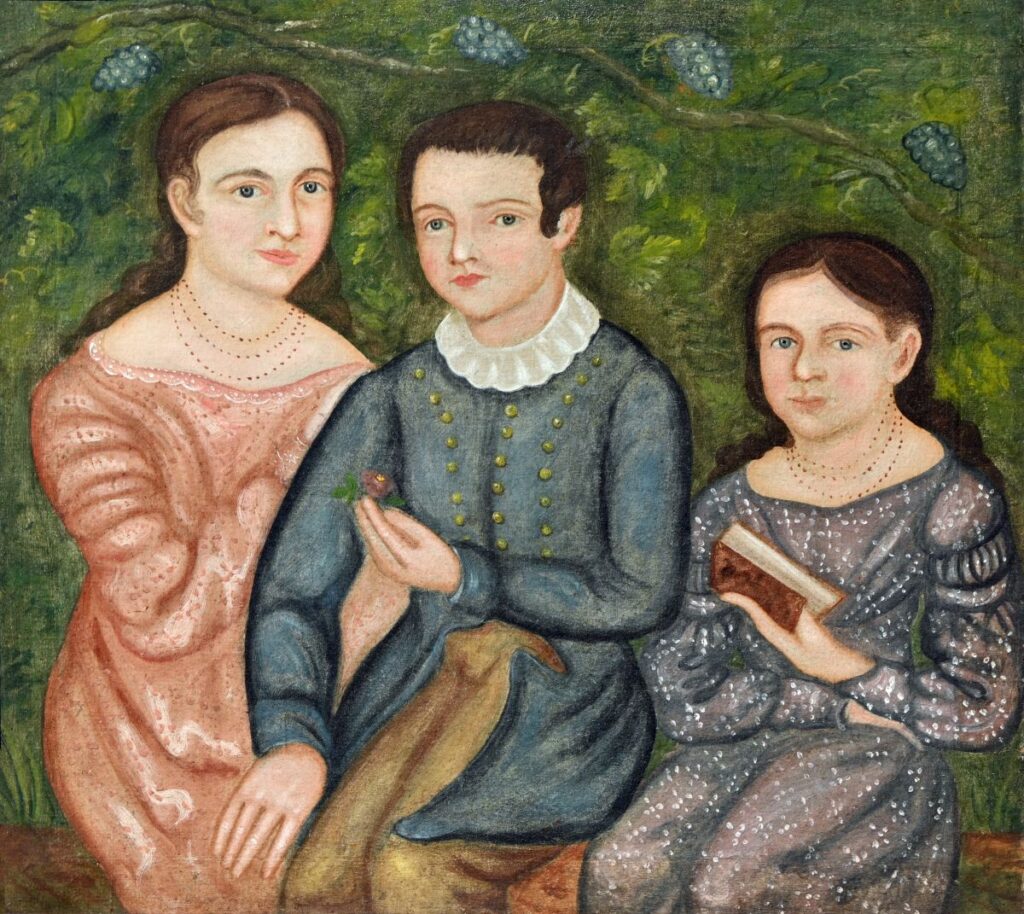
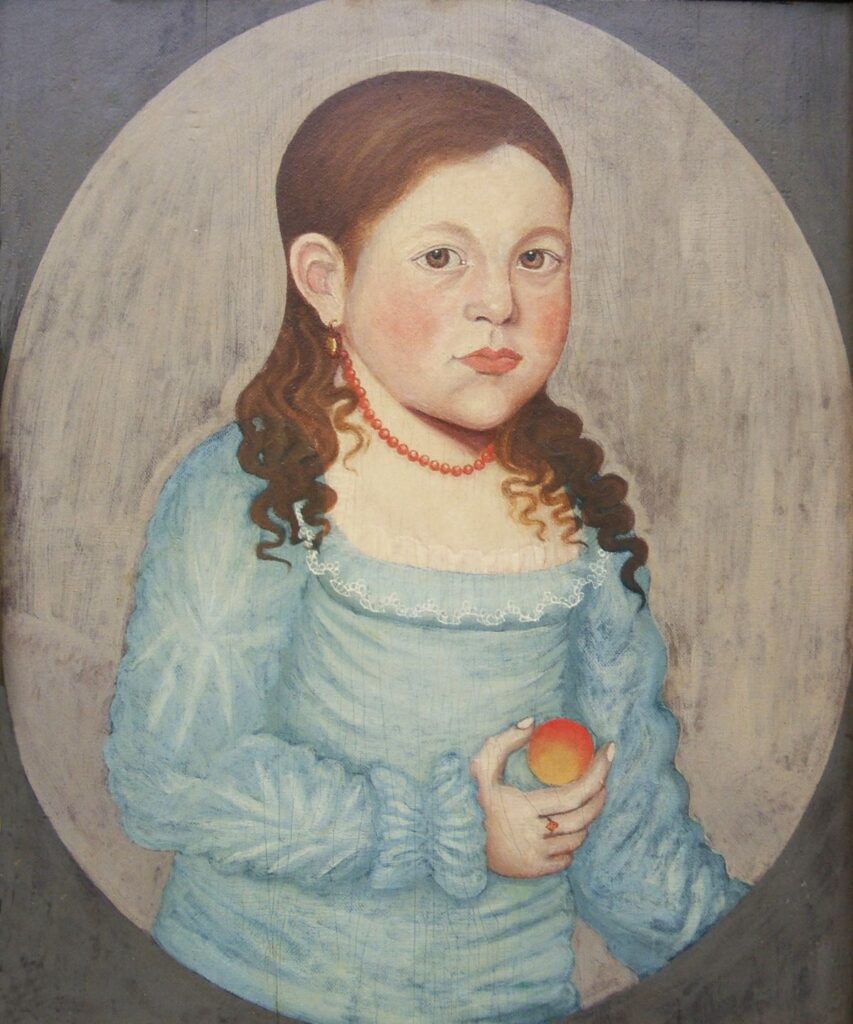
other Fiske family portraits by the same artist. With its heightened color bathed in rich light and vigorous individual brushstrokes, this likeness explores the tactile possibilities of paint to create texture, vivacity, and freshness.
American’s interest in portraiture was also heightened by attempts to understand human personality and behavior. Physiognomy and phrenology were widely accepted as ways to analyze a person’s character with “scientific” precision. Physiognomy, popularized by the Swiss theologian Johann Caspar Lavater, taught that character traits could be understood from a person’s physical features, particularly the face. Phrenology, developed in 1796 by Franz Joseph Gall of Vienna, held that mental traits were correlated with specific areas of the brain. Johann Kaspar Spurzheim, another proponent of phrenology, asserted that since the skull’s contour replicates the brain, the bumps and shape of the skull were manifestations of “faculties,” each regulating a separate aspect of a person’s character. Examination of the face and skull became extremely popular ways to judge one’s strengths and weaknesses and to learn ways for self-improvement.14 Portrait artist Joseph Whiting Stock (1815–1855), who painted illustrations for professional phrenologists, owned a plaster phrenology head as well as texts on the subject (Fig. 7).15
Along with a commitment to produce a recognizable image of the sitter, Federal American vernacular portrait painters were influenced by these new ideas that celebrated creative imagination. As one magazine noted in 1812, the fine arts “are the produce of the imagination, their essence consists of expression, their end pleasure.”16 The portrait became part fact and part fancy: a vivid, innovative representation of the sitter’s character using simplified form, expressive color, and an enhanced decorative impression. In these works, the sitter appears at the surface of the canvas, ready to step into the viewer’s world. The frame acts as a window through which to view the subject, who is often so close to that window that the sides of the body could not be included in the image (Figs. 9, 10).
The artifice of the portrait is loudly announced. The expected three-dimensional modeling and perspective have been minimized, making the sitter appear as a mosaic of interlocking flat shapes. Shadows are minimal, even though the portrait is illuminated by a flood of light that appears to enter from the viewer’s world, and often lends a sculptural quality to the image. The colors are bright, and when they abut one another, there is rarely any blending or transition. This encourages the viewer to focus on one component at a time.
Facial details often provide a youthful appearance, while eyes frequently convey intensity with a prominent limbal ring (the dark ring around the iris), which signifies attractiveness and a penetrating mind.17 The sitter’s and the viewer’s eyes meet, creating a sense of intimacy. In many portraits there is minimal interior space, with an empty background reduced to a single color, while others include a backdrop scene with varying degrees of detail (Figs. 12–14). Some artists use expressive brushstrokes in the background and the sitter’s clothing, adding further visual interest (Figs. 15–18). Stylish clothing with a profusion of ruffles often idealizes the sitter.
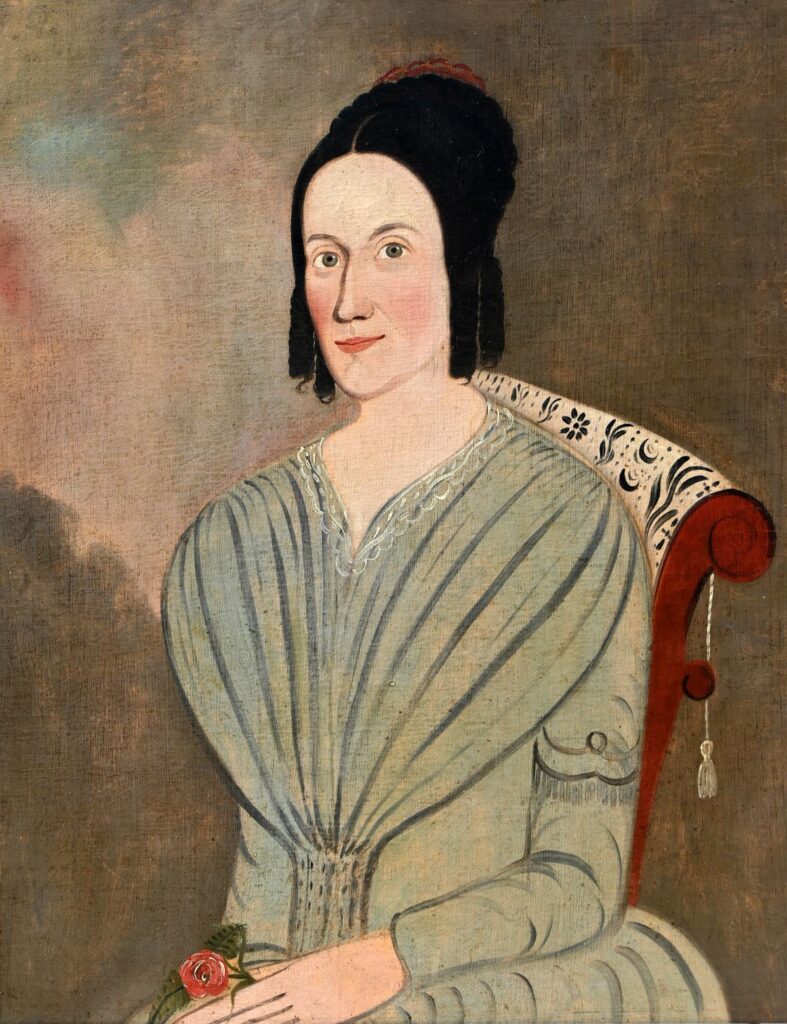
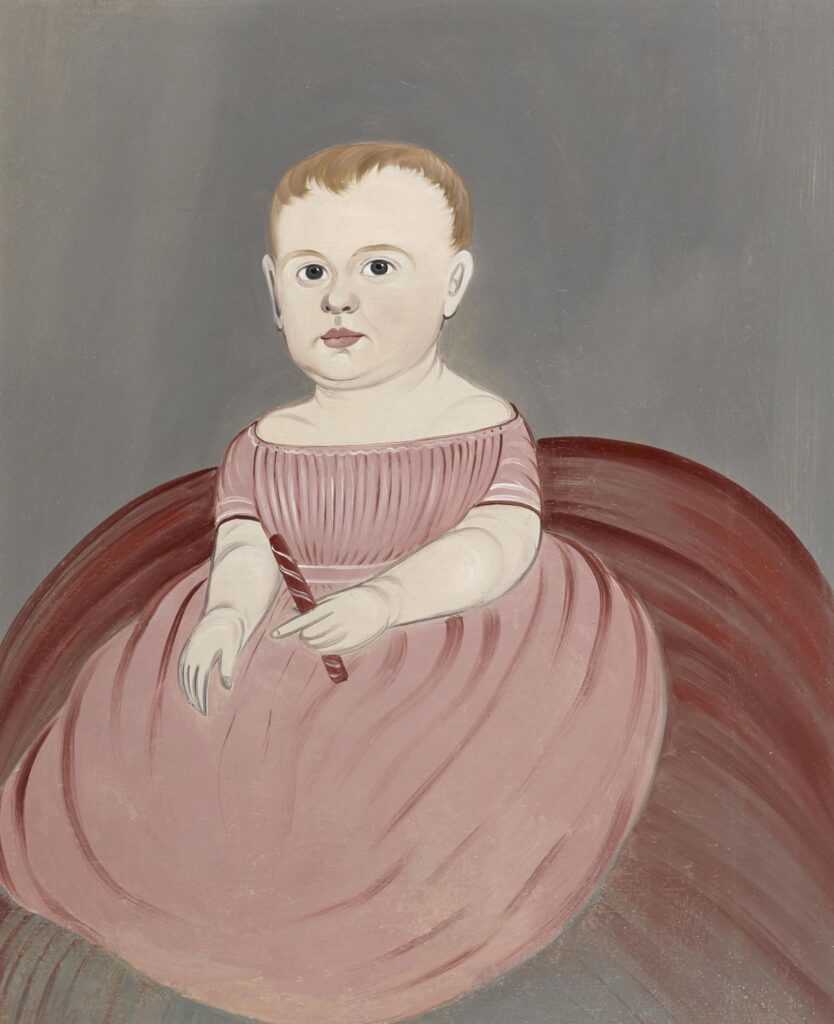
At the time they were painted, these vivid portraits must have been both startling and exciting. Light, color, shape, tension, and motion have been used to stimulate, often unconsciously, the viewer’s eye and mind. The portraits were described as undeceiving in their lively and heightened expressions of the sitters. While the portraits appear to be spontaneous renditions, or perhaps a distillation from memory, sitters and artists wrote of the lengthy multiple sittings that were required. No preliminary sketches have been located, so the likenesses were apparently painted directly onto the canvas. Some sitters complained that they were painted in a studio full of people eager to see an artist at work, an uncomfortable experience, with fellow townspeople staring at them and loudly expressing their opinions of the artist’s work.
Portraits became part of everyday life, with hundreds of artists at work during the first half of the nineteenth century, particularly in the more populated northeastern states. In 1842 Charles Dickens toured America and commented on this unique American portrait style, seeing it as a reflection of the spirit of optimism in America. He noted the portraits of an innkeeper and his infant son “looking as bold as lions and staring out of the canvas with an intensity that would have been cheap at any price.”18
Artists’ careers were buffeted by economic and technological changes. The Depression of 1837, perhaps the most severe economic downturn in American history, forced many artists to seek other livelihoods. Then, in 1839, Frenchman Louis-Jacques-Mande Daguerre invented photography. By 1842 a portrait painter in New York City had to advertise that he would “paint likenesses on ivory or paper at Daguerreotype prices.”19
Modern viewers often ask why the sitters in these early American portraits never smile, relax, or show warmth. We look at these paintings very differently from the original viewers, who believed that physical features were a manifestation of the sitter’s inner character. Today, any relationship between anatomical traits and personality is adamantly rejected. Instead of trying to understand the sitter’s inner self from the portrait, we see people wearing their finest clothing, projecting a fashionable identity that fills the canvas with a quiet dignity.
Federal American vernacular portraits from the late 1790s through the 1840s represent a noteworthy artistic genre with a unique American identity. The new nation experienced major philosophical and cultural changes during this period, as well as extraordinary growth in business, learning opportunities, and entrepreneurial desires. The portraits reflected these changing times with enhanced creative expression that combined form, tension, and color, which enlivened them with the spirit of romanticism. The untold number of portraits painted and their integration into the lives of average citizens indicate that they were an important aspect of American cultural identity. Today, we marvel at the originality, simplicity, use of color, and freshness of these likenesses. The different styles each artist developed also heighten our interest in the paintings. We have to stop and remember what these appealing portraits represented and accomplished during the first half of the nineteenth century.
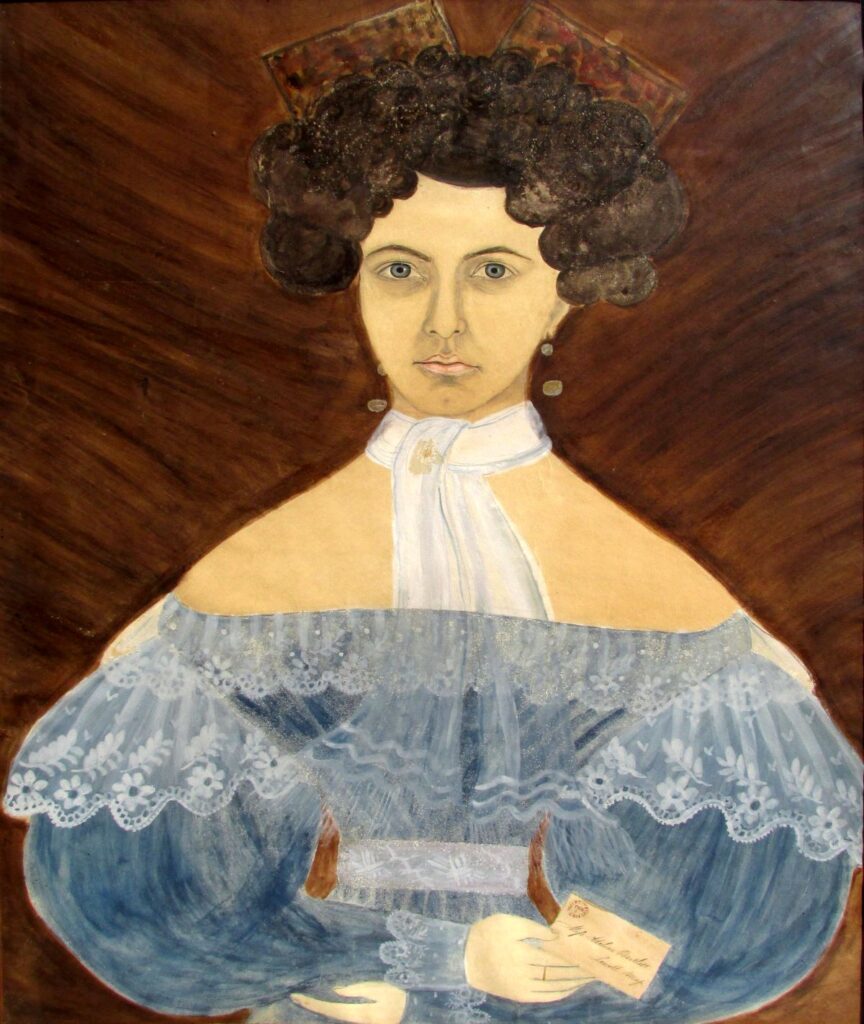
1 The information and Susanna Paine quotations in this article are from Michael R.Payne and Suzanne Rudnick Payne, “Roses and Thorns: The Life of Susanna Paine,” Folk Art, vol. 30, no. 4 (Winter 2005/2006), pp. 62–71. 2 Mona L. Dearborn, “Guy Atkinson and the Itinerant Artists of Fairfax Street, Alexandria,” Journal of the Early Southern Decorative Arts, vol. 22, no. 1 (Summer 1996), p. 18. 3 Peter C. Marzio, The Art Crusade: An Analysis of American Drawing Manuals, 1820–1860 (Washington, DC: Smithsonian Institution Press, 1976), p. 1. More than 145 drawing instruction book titles were published by American authors between 1820 and 1860. 4 Alexandria (VA) Daily Advertiser, March 14, 1808. 5 Mary Kelley, Learning to Stand and Speak (Chapel Hill: University of North Carolina Press, 2008). 6 The information and Wetherby quotations in this article are from Michael R. Payne and Suzanne Rudnick Payne, “The Business of an American Folk Portrait Painter: Isaac Augustus Wetherby,” Folk Art, vol. 32, no. 1 (Winter 2007), pp. 58–67. 7 Michael R. Payne and Suzanne Rudnick Payne, “Augustus Fuller: Triumph over Disability A Deaf Folk Portrait Painter in Nineteenth-Century America,” Antiques and Fine Art, vol. 16, no. 4 (Winter 2017), pp. 90–95. 8 James Guild, “From Tunbridge, Vermont, to London England—The Journal of James Guild, Peddler, Tinker, Schoolmaster, Portrait Painter, From 1818 to 1824,” Proceedings of the Vermont Historical Society, vol. 5, no. 3 (September 1937), pp. 249–314, available at vermonthistory.org, selected articles, 1930–1939. 9 Information about preparing and acquiring the needed art materials is from Lance Mayer and Gay Myers, American Painters on Technique: The Colonial Period to 1860 (Los Angeles: Getty Publications, 2011). 10 Suzanne Rudnick Payne and Michael R. Payne, “To Please the Eye: Justus Da Lee and His Family,” Folk Art, vol. 29, no. 4 (Winter 2004/2005), pp. 46–57. 11 Colin Campbell, The Romantic Ethic and the Spirit of Modern Consumerism (Oxford, UK: Blackwell, 1987); and Tim Blanning, The Romantic Revolution: A History (New York: Modern Library, 2011). 12 The authors have transcribed the letters of Ira Chaffee Goodell, the source for this quotation, in preparation for publication. 13 Richard Harter Fogle, The Romantic Movement in American Writing (New York: Odyssey Press, 1966). The era of romanticism in American literature has been variously described as 1790–1840 and 1820–1870. 14 Christopher Lukasik, “The Face of the Public,” Journal of Early American Literature, vol. 39, no. 3 (2004), p. 413–464. 15 Juliette Tomlinson, The Paintings and the Journal of Joseph Whiting Stock (Middletown, CT: Wesleyan University Press, 1976). 16 Editor, “The Fine Arts,” Halcyon Luminary and Theological Repository, vol. 1, issue 1 (January 1, 1812), p. 19. 17 Darren Peshek et al., “Preliminary Evidence that the Limbal Ring Influences Facial Attractiveness,” Evolutionary Psychology, vol. 9, no. 2 (2011), pp. 137–146. 18 Charles Dickens, American Notes for General Circulation (Paris: Baudry’s European Library, 1842), p. 232. 19 New York Evening Post, October 24, 1842, p. 3.
SUZANNE RUDNICK PAYNE and MICHAEL R. PAYNE are collectors and members of the American Folk Art Society. This is their twenty-second article about early American folk art.

